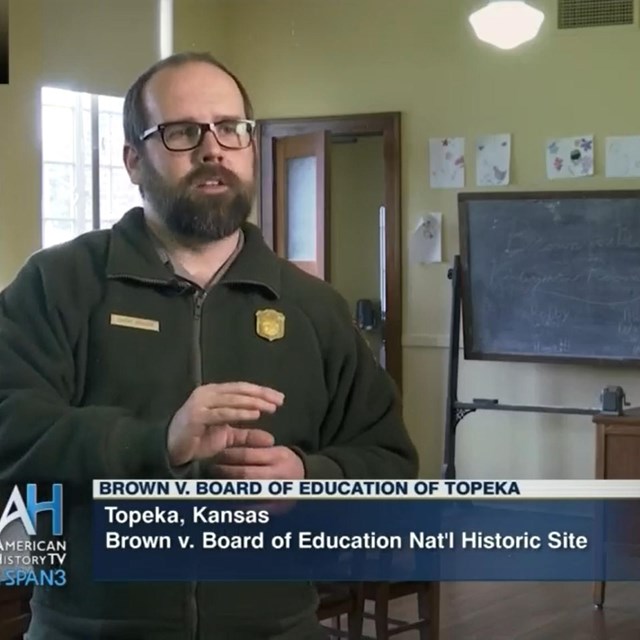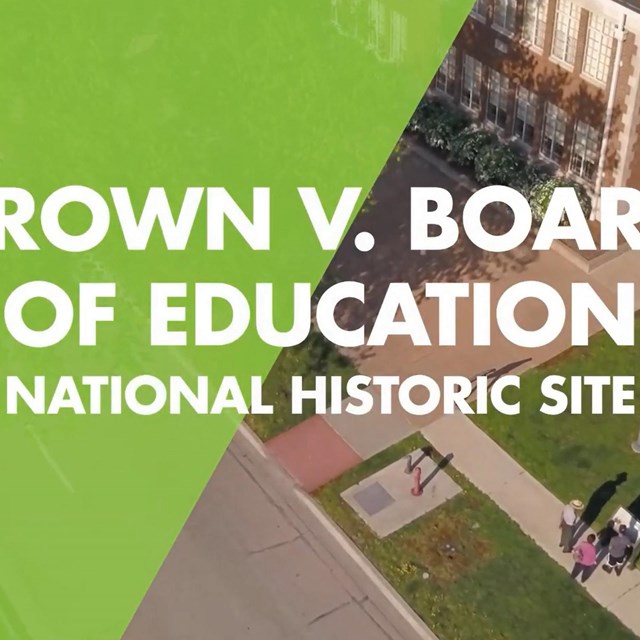|
Visit our keyboard shortcuts docs for details
Park Guide Fatimah Purvis takes us through the life and achievements of Charles Hamilton Houston, the man who 'killed' Jim Crow. Houston led the development of the NAACP's plan and approach to challenge segregation, which eventually led to the Brown v. Board of Education decision.
Visit our keyboard shortcuts docs for details
Randy Standingwater sits down with Dr. Valerie Mendoza of Washburn University to discuss the Mendez v. Westminster case and its role in setting the platform for Brown v. Board of Education.
Visit our keyboard shortcuts docs for details
To mark the 67th anniversary of the Brown v. Board of Education decision, Park Rangers at the Brown v. Board of Education National Historic Site sat down with three experts to discuss the case.
Visit our keyboard shortcuts docs for details
Join Park Guide Fatimah Purvis as she reads Coretta Scott! This Reading with a Ranger session follows the life of Coretta Scott King and the rise of the Modern Civil Rights Movement. (Video audio described by narrator. Written permission from HarperCollins Publisher was granted to make this video)
Visit our keyboard shortcuts docs for details
Join Park Guide Fatimah Purvis as she reads Ruth and the Green Book! The story follows a young girl named Ruth in the 1950s as her family takes a trip in their new car to visit her grandmother. During the trip Ruth experiences some harsh realities of what it meant to be African American at the time. This narrative provides children a glimpse at segregation and can lead to learning opportunities. (Video audio describe by narrator. Video created with written permission from Lerner Publishing Group) TranscriptRanger Rachel: Allen! Where have you been? Allen the Eagle: Rachel, I have been to some of the most amazing national parks in this country. First, I visited the Statue of Liberty. Now that is one very tall lady. Rachel: She sure is. Over a hundred feet tall. Did you know that the Statue of Liberty was given to America as a gift of friendship from France? Allen: A gift? I bet they needed a really big bow. Rachel: I don’t know about that. But I do know that the Statue of Liberty stands for a really big idea. Freedom. So where else have you been? Allen: Well, cowpoke, they told me, “Go west, young eagle, go west!” So I soared on over to South Dakota where I visited Mount Rushmore. I’ll tell ya, those guys don’t talk much. Rachel: Allen, you do know that those figures are carved into the mountain, don’t you? Allen: Ah, carved into the side of the mountain? Yeah, I knew that. Rachel: Mount Rushmore honors four great American leaders: George Washington, Thomas Jefferson, Theodore Roosevelt, and Abraham Lincoln. Allen: Hey, weren’t all those guys president? Rachel: Yes, they were. And they were all very important to the history of our nation. Allen: So, what’s up with this place? Rachel: Well, this is also a national park and it’s very important to the history of our nation. This is the Brown v. Board of Education National Historic Site. Allen: Oh, I hear a story coming on. Rachel: Yes, you do. Not so very long ago, African American children went to school in this very building. Allen: Right here? In this building? Rachel: Yes, Allen. Right here. But going to school here confused some African American kids. Do you know why? Allen: Yeah, I know why. Vegetables! They were confused because parents and teachers are always trying to make you eat your vegetables. Sometimes I don’t want to eat vegetables. Sometimes I only like pizza, or hamburger… Rachel: Allen, it wasn’t because of vegetables. These kids were confused because there were different schools for kids who were African American, kids who were white, and kids who spoke a different language. Allen: What do you mean? Rachel: Well, kids of different races played together in the neighborhoods but when it was time to go to school, they all went to different schools. African American kids, white kids, and kids whose families spoke different languages could not go to school together. Allen: Why? Rachel: Because of segregation. Allen: What do you mean…segregation? Rachel: It was a terrible thing but for a long time in our country, it was against the law for kids of different races to go to school together. Allen: Wait just a minute. Are you telling me that in the United States of America, some kids couldn’t go to school with their friends because their skin was a different color? Rachel: Yes, that’s what I’m telling you. Allen: Well, that’s just not fair! Rachel: You’re absolutely right. That’s not fair. Allen: Somebody needs to do something! Rachel: You’re right again. And somebody did. The parents of the kids who were being treated unfairly stood up as leaders and asked the Supreme Court of the United States to make things right. Allen: So, what happened? Rachel: In a case called Brown v. Board of Education, the Supreme Court said segregation was wrong. They said all kids should be treated equally and fairly as citizens. Allen: Fair is important. Rachel: Yes, very important. Just think about how you’d feel when you’re not treated fairly. Allen: It makes me an awfully sad eagle but it also makes me mad and maybe a little afraid too. Rachel: We don’t want to make anyone feel sad, mad or afraid. Let’s talk about how you show you care about being fair. Rachel singing: Fair is fair Show you care Invite! Be polite! Can I count on you To do what’s right? Fair is fair! Rachel: Here’s the first thing you can do to show you care about being fair. Invite everyone to join in. Including everyone is a great way to show you care about being fair. It’s especially important to include people who might seem a little different from you. Allen: Sometimes, that feels scary. Rachel: I know it does but sometimes being fair means you have to be brave and be a leader. Here’s the thing, if you don’t include people who are different from you, if you don’t invite them to join in, then you’re saying to them you’re not good enough to play with us. Allen: And then they’ll feel sad, and mad, and afraid. Rachel: That’s right. Allen: I’ll bet that’s how those kids felt when they couldn’t go to school with their friends. Rachel singing: Fair is fair Allen singing: Fair is fair Rachel singing: Show you care Allen singing: About being fair Rachel and Allen singing: Invite! Be polite! Can I count on you to do what’s right? Fair is fair! Rachel: There’s another thing you can do to show you care about being fair and that is: be polite. Allen: You mean like saying please and thank you? Rachel: Saying please and thank you are a great start. Nice words like please and thank you are a way you can show kindness and respect to people. When you use nice words, you show you care about being fair. Allen: But sometimes, people use words that aren’t so nice. In fact, they’re really mean. Rachel: Unfortunately, that’s true. Teasing or calling people names can really hurt people’s feelings. Allen: And that’s not fair. Rachel: It certainly isn’t. Allen: Did people call African American kids mean names? Rachel: Well, it’s really sad but African American kids, and kids of different races, were called some very mean names. Allen: I’ll bet they felt bad. Rachel: I’m sure they did. But here’s something I want you to remember. The Supreme Court and the people of the United States believed everyone should be treated fairly. That’s why we have a national park in the school that some of kids attended. This park helps to show that we care about being fair. So I want you to sing along with me now. Rachel singing: Fair is fair Allen singing: Fair is fair Rachel singing: Show you care Allen singing: About being fair Rachel and Allen singing: Invite! Be polite! Can I count on you to do what’s right? Fair is fair!
Visit our keyboard shortcuts docs for details
This 10–12-minute educational video is targeted to pre-school and early primary grade children. It is designed to convey, in an age-appropriate manner, the major themes of fairness, respect, courtesy, and getting along with others encompassed in the Brown v. Board of Education decision. 
Additional External Presentations
|
Last updated: April 17, 2025


